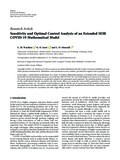Please use this identifier to cite or link to this item:
http://ir-library.mmust.ac.ke:8080/xmlui/handle/123456789/2110Full metadata record
| DC Field | Value | Language |
|---|---|---|
| dc.contributor.author | C., M. Wachira | - |
| dc.contributor.author | G., O. Lawi | - |
| dc.contributor.author | L., O. Omondi | - |
| dc.date.accessioned | 2022-11-04T13:01:41Z | - |
| dc.date.available | 2022-11-04T13:01:41Z | - |
| dc.date.issued | 2022-10-15 | - |
| dc.identifier.uri | https://www.hindawi.com/journals/jmath/2022/1476607/ | - |
| dc.identifier.uri | https://doi.org/10.1155/2022/1476607 | - |
| dc.identifier.uri | http://ir-library.mmust.ac.ke:8080/xmlui/handle/123456789/2110 | - |
| dc.description.abstract | In this paper, a mathematical model based on a system of ordinary differential equations is developed with vaccination as an intervention for the transmission dynamics of coronavirus 2019 (COVID-19). The model solutions are shown to be well posed. The vaccine reproduction number is computed by using the next-generation matrix approach. The sensitivity analysis carried out on this model showed that the vaccination rate and vaccine efficacy are among the most sensitive parameters of the vaccine reproduction number, . The optimal control problem is solved with the rate of vaccination and the transition rate from the vaccinated class to the infected class as control variables. Finally, the numerical simulations showed that the control intervention should aim to increase the vaccination rate with a high-efficacy vaccine. | en_US |
| dc.language.iso | en | en_US |
| dc.publisher | Hindawi Journal of Mathematics | en_US |
| dc.title | Sensitivity and Optimal Control Analysis of an Extended SEIR COVID-19 Mathematical Model | en_US |
| dc.type | Article | en_US |
| Appears in Collections: | Gold Collection | |
Files in This Item:
| File | Description | Size | Format | |
|---|---|---|---|---|
| Sensitivity_and_Optimal_Control_Analysis_of_an_Ext.pdf | 655.04 kB | Adobe PDF |  View/Open |
Items in DSpace are protected by copyright, with all rights reserved, unless otherwise indicated.
